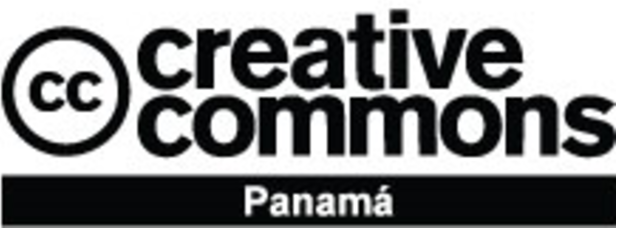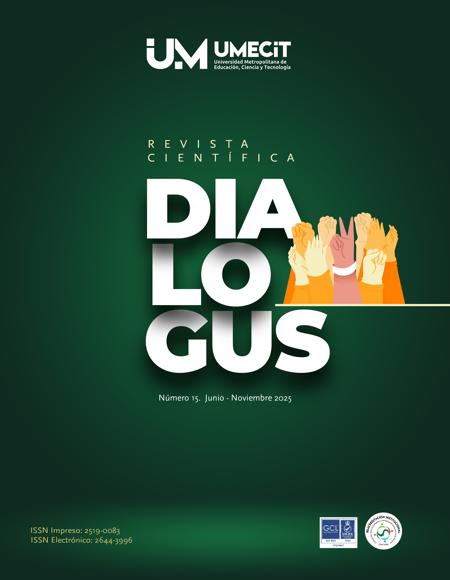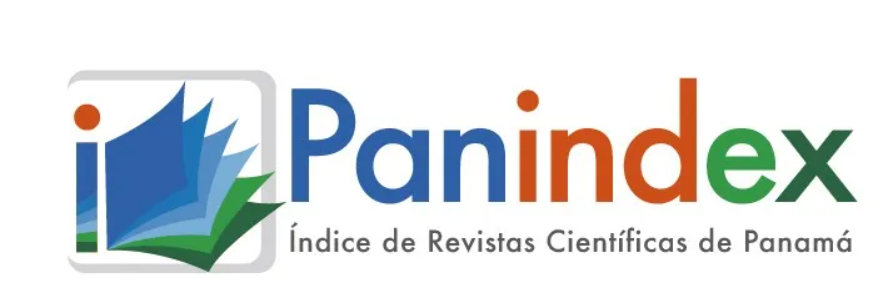The content of the publications and the links suggested in them are the sole responsibility of the authors and not of the METROPOLITAN UNIVERSITY OF EDUCATION, SCIENCE AND TECHNOLOGY (UMECIT) or DIALOGUS magazine. They are protected by international copyright laws as well as the UMECIT and DIALOGUS logos, hence their reproduction is totally prohibited.
This work is licensed under a Creative Commons Attribution-NonCommercial-NoDerivatives 4.0 International License.
The authors maintain the copyright and transfer the right of the first publication to the journal, with the article registered with Creative Commons Attribution-NonCommercial-NoDerivatives License, which allow others They can download the works published in this magazine and share them with other people, as long as their authorship is recognized, but they cannot be changed in any way nor can they be used commercially.
Authors are recommended to include their work in social networks such as Researchgate and institutional repositories once the article or visible fact has been published on the journal page, without forgetting to include the digital document identifier and the name of the journal.



Abstract
The present study aimed to evaluate the effectiveness of an audiovisual sensory educational material in the learning process of neurodivergent children, specifically in the context of El Refugio. An experimental design was used with a group of children who participated in interactive activities using audiovisual materials that combined visual and auditory stimuli, with a special focus on the colors blue and orange. Direct observation and teacher evaluation were employed to measure participation, comprehension, and retention of content about the continents. The results showed a significant improvement in the children’s participation, as they were excited and motivated when interacting with the material. Most children demonstrated an increased ability to identify the continents, and the combination of colors was particularly effective in promoting concentration and calmness. The implementation of audiovisual sensory material proved to be highly effective in enhancing the learning process of neurodivergent children, standing out for its ability to capture attention and encourage active participation. The implications of these findings suggest that the use of adapted sensory materials can be a key resource to overcome learning barriers for this group of children, with its integration recommended in other educational areas.
Keywords
References
Bessell, C. (2015). Lanzamos el Observatorio Regional de Educación Inclusiva. Clade. https://redclade.org/acciones-recientes/se-lanza-el-observatorio-regional-de-educacion-inclusiva/
Concha-Díaz, M. V., Bakieva, M., & Jornet Meliá, J. M. (2019). Sistemas de atención a la educación infantil en América Latina y El Caribe (AL y C). Publicaciones de la Facultad de Educacion y Humanidades del Campus de Melilla, 49(1), 113-136. https://doi.org/10.30827/publicaciones.v49i1.9857
Delgado Valdivieso, K., Vivas Paspuel, D. A., Carrión Berrú, C. B., & Reyes Masa, B. del C. (2022). Educación inclusiva en América Latina: Trayectorias de una educación segmentada. Revista de ciencias sociales, 28(Extra 5), 18-35. https://dialnet.unirioja.es/servlet/articulo?codigo=8471670
El Heraldo. (2023). El sistema educativo registra más de 30 mil niños con discapacidad. https://www.elheraldo.hn/honduras/sistema-educativo-honduras-registra-mas-de-30-mil-ninos-con-discapacidad-DC14346353
El Refugio. (s. f.). El Refugio Honduras. https://www.refugio.ch/
Fernández Parrón, A. (2024, marzo 31). Cómo los colores DISC pueden apoyar a una persona neurodivergente en un entorno respetuoso—Empresas autistas. https://www.empresasautistas.com/como-los-colores-disc-pueden-apoyar-a-una-persona-neurodivergente-en-un-entorno-respetuoso/
Fundación Juan VIII. (2023). ¿Para qué sirve la estimulación sensorial? ¿Cómo se lleva a cabo? https://blog.fundacionjuanxxiii.org/para-que-sirve-la-estimulacion-sensorial-como-se-lleva-a-cabo
Fundación para la Educación Ricardo Ernesto Maduro Andreu. (2022). Informe de progreso educativo: Honduras 2022. https://ferema.org:8000/pubFiles/1654629356878_InformeProgesoEducativo_Honduras_2022.pdf
Gobierno de La Republica de Honduras, H. (2005). Ley de Equidad y Desarrollo Integral para las Personas con Discapacidad Decreto 160—2005. https://repositorio-chepes.sedesol.gob.hn/handle/123456789/61
Kaga, Y., & Sretenov, D. (2021). Inclusión en la atención y la educación de la primera infancia: Informe sobre inclusión y educación—UNESCO. https://unesdoc.unesco.org/ark:/48223/pf0000379502_spa
La Organización de las Naciones Unidas para la Educación, la Ciencia y la Cultura, U. (2009). Directrices sobre políticas de inclusión en la educación—UNESCO. https://unesdoc.unesco.org/ark:/48223/pf0000177849_spa
La Organización de las Naciones Unidas para la Educación, la Ciencia y la Cultura, U. (2021). La inclusión de educandos con discapacidad en entornos de aprendizaje de calidad: Herramienta de apoyo a los países en su avance hacia la educación inclusiva—UNESCO Biblioteca Digital. https://unesdoc.unesco.org/ark:/48223/pf0000380256_spa
La Organización de las Naciones Unidas para la Educación, la Ciencia y la Cultura, U. (2023). Qué debe saber acerca de la inclusión en la educación. https://www.unesco.org/es/inclusion-education/need-know
Latas, Á. P., Raposo-Rivas, M., Martínez-Figueira, E., & Doval, M. a I. (2017). Materiales didácticos para todos: El carácter inclusivo de fotovoz. Educatio Siglo XXI, 35(3 Nov-Feb1), Article 3 Nov-Feb1. https://doi.org/10.6018/j/308881
Mejia–Elvir, P. (2022). Estrategias inclusivas: Atención al estudiantado con diversidad en educación básica, experiencia del profesorado hondureño. Innovaciones Educativas, 24(36), 131-145. https://doi.org/10.22458/ie.v24i36.3913
Miller, C. (2024). ¿Qué es la neurodiversidad? Child Mind Institute. https://childmind.org/es/articulo/que-es-la-neurodiversidad/
Moncada, G., Larios, B., & Mauricio, J. (2020). Estatus socioeconómico y educación en Honduras: Estatus socioeconómico e inclusión escolar en Honduras—UNESCO. https://unesdoc.unesco.org/ark:/48223/pf0000374697
Moreno Lucas, F. M. (2015). La utilización de los materiales como estrategia de aprendizaje sensorial en infantil. Opción: Revista de Ciencias Humanas y Sociales, 2(Extra 2), 772-789. https://dialnet.unirioja.es/servlet/articulo?codigo=5834781
Paz-Maldonado, E. (2020). Una Aproximación Teórica sobre la Educación Inclusiva en Honduras: Avances, Obstáculos y Desafíos. Revista Brasileira de Educação Especial, 26, 371-386. https://doi.org/10.1590/1980-54702020v26e0049
Plarre, M. (2024, septiembre 29). Materiales sensoriales Montessori: Clave para el desarrollo infantil. Método Montessori. https://www.detodomontessori.com/materiales-sensoriales-montessori-clave-para-el-desarrollo-infantil/
Puente, B. de la, & Luis, J. (2009). Hacia una educación inclusiva para todos. Revista complutense de educación, 20, 19. https://redined.educacion.gob.es/xmlui/handle/11162/124342
Secretaría de Educación. (2022). Educación Lanza el año de la Inclusión Educativa en Honduras. https://www.se.gob.hn/detalle-articulo/1882/
Secretaría de Educación de Honduras. (2024). Secretaría de Educación inicia la construcción de los lineamientos generales del plan de Oferta y demanda Educativa 2024. https://www.se.gob.hn/detalle-articulo/2074/
Tang, Q. (2017). Guía para asegurar la inclusión y la equidad en la educación—UNESCO. https://unesdoc.unesco.org/ark:/48223/pf0000259592
United Nations International Children’s Emergency Fund), U. (2022). Hacia la educación inclusiva en América Latina y el Caribe | UNICEF. https://www.unicef.org/lac/hacia-la-educaci%C3%B3n-inclusiva-en-am%C3%A9rica-latina-y-el-caribe
Wittwer, C. (2024). Situación Actual de El Refugio [Comunicación personal].
Downloads
Publication Facts
Reviewer profiles N/A
Author statements
- Academic society
- Universidad Metropolitana de Educación, Ciencia y Tecnología
- Publisher
- Universidad Metropolitana de Educación, Ciencia y Tecnología




















